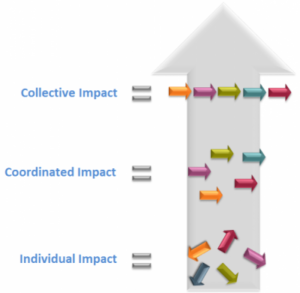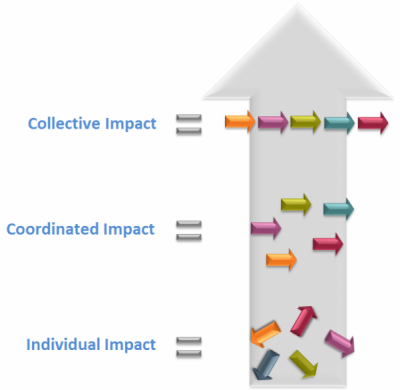 I had the great fortune of attending the first learning community of the Working Cities Challenge (WCC), an initiative led by the Federal Reserve Bank of Boston to advance collaborative leadership and support ambitious work to improve the lives of low-income people in smaller Massachusetts cities. Passionate leaders talked through a number of challenging issues that have the potential to sow bitterness and discord in collective impact Initiatives. By addressing the conflicts and holding the tensions in balance, that bitterness can become a sweet recipe for catalyzing enduring change.
I had the great fortune of attending the first learning community of the Working Cities Challenge (WCC), an initiative led by the Federal Reserve Bank of Boston to advance collaborative leadership and support ambitious work to improve the lives of low-income people in smaller Massachusetts cities. Passionate leaders talked through a number of challenging issues that have the potential to sow bitterness and discord in collective impact Initiatives. By addressing the conflicts and holding the tensions in balance, that bitterness can become a sweet recipe for catalyzing enduring change.
Here are 8 Yummy Tensions of Collective Impact that I shared with them in my closing remarks:
- Humility vs. Hubris– One of my favorite sayings from our Living Cities CEO Ben Hecht is that we have the “humility to know that we don’t have all the answers, but the hubris to try.” That about sums up the schizophrenia of the work of collective impact. Many committed, passionate, and intelligent people have combatted some of our country’s most pressing problems, and most of these efforts have resulted in incremental change. So who the heck do we think we are that we are going to achieve something different? There’s a danger in believing that because of collective impact we are better or smarter than those who came before us. We are not. Collective impact is just a mechanism that allows us to learn more quickly. Part of rapid learning includes being more comfortable when things we try don’t work out. And having cross-sector partners who both define and buy into the change we seek allows us the freedom to fail together with less fear of repercussions.
- Cross-sector Engagement vs. Existence – One of the key elements of collective impactis building a cross-sector partnership. And this really ticks a whole bunch of people off because it seems like a trumped up facelift of something we’ve been all doing for years – collaboration. The folks at StriveTogetherhave a great visual of the difference between collaboration (i.e. coordinated impact) and collective impact. Another way to sum it up is that having an engaged cross-sector partnership is different than having one that simply exists. An engaged cross-sector partnership is comfortable having tough conversations with each other. Partners are willing to subjugate their individual interests for what will drive the ambitious change everyone has agreed to. When the initiative is facing heat, different cross-sector partners will navigate backlash on behalf of each other’s organizations, always keeping in mind the group’s or partner’s audacious goal. This is a result of investing in building the connective tissue amongst organizations so they create a shared identity. Instead of a loose consortium of organizations, they operate as one team and the enemy is not each other, but instead, whatever is preventing them from making progress toward their collective goal.
- Ambitious vs. Achievable – At Living Cities, we recognize the importance of both BHAGs(Big Hairy Audacious Goals, aka Shared Result) and SMART goals(Specific Measurable Achievable Relevant Time-bound). The Audacious and Achievable can often feel in conflict with each other and negotiating that tension is usually more of an art than a science. One way we bridge that gap is to share criteria that sites can apply as they think about the goals they are developing for different time periods. For example, Shared Results should:
- Take 10+ years to achieve;
- Have a “gulp factor”;
- Require a cross-sector partnership to achieve as opposed to individual programs;
- Be stated generically, not naming any projects or activities in the statement.
Example: The labor force participation rate of African-American working age men is increased by X%.
We have developed criteria not just for the longer term audacious goal, but also for the interim outcomes that help our sites assess if they are on or off track as they work to catalyze enduring change in their communities.
- Solutions vs. Hypotheses – During Living Cities’ first round of The Integration Initiative(TII), we spent a lot of time telling people that we didn’t invest in programs. That distinction was esoteric at best and confusing at worst. That said, as many of you may have experienced, it is often easier to rip an infant from the arms of a mother than to stop a program once it has been funded in the government. This is understandable since usually a whole bunch of smart people worked their butts off to get a program funded by sharing their extensive research about why it will “solve the problems that ail us”. When these programs begin showing themselves to be less effective, the work it took to get the resources to support the program in the first place can often create backlash that hamstrings leadership in the future. That is why we work with our sites to build hypotheses about what will drive their Shared Results. By using language that underscores that we are always testing hypotheses as opposed to mandating solutions, it provides our cross-sector partnerships with licenses to fail in service of finding what works.
- Learners vs. Experts– Committing to a learning orientation amongst a group of peers from external organizations is harder than it sounds. More likely than not, your partners were invited to participate because of their expertise. They have been rewarded and promoted throughout their professional career because of their experience. And now we ask them to sit in a room in front of each other and expose all the things they do wrong every day and don’t know how to fix. This is not a behavior that feels natural for most people and it involves a level of risk and vulnerability most are not expected to exhibit daily. Since this is a muscle that can be built over time, it is important to invest in periods of reflection and opportunities to build trust within the cross-sector partnerships. These efforts move at the speed of trust so not investing the time or failing to make room for what seem like ‘touchy-feely, nice to have’ conversations can negatively impact what your group can accomplish and how quickly.
- Rigorous vs. Prescriptive – With all these yummy tensions, several team members may begin either demanding the manual or worshipping every whitepaper from FSGas the Bible. One of our Initiative Directors from TII asked me if it was okay that their backbone didn’t follow the guidelines she had read online. She was so anxious; you would have thought Moses had received an additional tablet etched with the Collective Impact Commandments! At Living Cities, we purposely state that we are “applying the principles of collective impact” to underscore that it is not a prescription, but a recipe. The best recipes are very rigorous- they tell you the ingredients, the order, the temperature. But they are also flexible! You can use egg or egg whites for the binding agent, sugar or sweet and low or applesauce for sweetness, butter or oil or margarine for fluffiness. What you use is based on who you’re serving and their needs and preferences. Likewise, when applying the principles of collective impact, it’s important that the powerof the tool is having someone wield it who is knowledgeable about the needs of the community they serve.
- Network Strength vs. Individual Strength – The folks at Living Cities and WCC invest in creating learning communities because they serve as a multiplier effect for collective impact efforts. For those who aren’t in a learning community, online resources like the Collective Impact Forumare also committed to sharing real time learning in public. By leveraging the strengths of our network, we are able to begin disseminating what’s working, what’s not working, and most importantly: why. There is a popular saying that the point is not the destination, it’s the journey. Well, that’s a really hard pill to swallow for folks committed to driving change in their communities. The path to continuous improvement often feels meandering and rife with wrong turns and briar patches. And while the Shared Result is the north star of our efforts, most of us would prefer to just have a GPS with turn by turn navigation. Often the best compass we have is the shared experience of those in other places who are on a similar journey to us. In many ways, we are on the frontier of social innovation, and when we circle our wagons and share through relationships and word of mouth, it helps leave well-worn trails for those coming behind us that accelerate their efforts for their communities.
- Unique vs. Special – Sometimes when we share our stories with fellow travelers, the first thing that comes to mind is all the ways our efforts are different from theirs.
- “They’re focusing on African-Americans, while our population is Latino.”
- “If we had a strong tech sector, maybe we’d focus on small business growth, but we don’t.”
- “Their economy is experiencing growth while ours is contracting so that doesn’t apply.”
It is absolutely important to have a discerning eye as you share promising practices with each other. From what we’ve seen implementing this approach across the country, no one has ever been able to lift a strategy wholesale from one community and plop it into another. That said, if you listen to the adages within the network, you might realize that while your community is unique, it may not be special. Perhaps what you’re facing is like a dollop of Detroit mixed with a smattering of Albuquerque. Or it’s pretty much identical to Baltimore, but you’d swap out a few ingredients from San Francisco. Regardless of what you’re facing, what we’ve noticed is that someone, somewhere has confronted that issue, and you can learn a great deal from what worked and what didn’t, even if it is not a one for one match.
Have you experienced other yummy tensions? If so, we’d love to hear more and look forward to continuing our journey of learning together.
Article written by Tynesia Boyea-Robinson, director of Collective Impact at Living Cities, Inc.
This post originally appeared on LivingCities.org at http://collectiveimpactforum.org/blogs/28291/8-yummy-tensions-collective-impact

